Tingling in Left Side of Neck and Shoulder: Identifying Pinched Nerve Symptoms
How to determine if you have a pinched nerve in your neck. What are the common symptoms of cervical radiculopathy. Which self-tests can help diagnose a pinched nerve. When should you seek medical attention for neck and shoulder tingling.
Understanding Cervical Radiculopathy: Causes and Symptoms
Cervical radiculopathy, commonly known as a pinched nerve in the neck, occurs when a nerve root in the cervical spine becomes compressed or irritated. This condition can lead to a variety of symptoms, including tingling in the left side of the neck and shoulder. Understanding the causes and recognizing the symptoms is crucial for proper diagnosis and treatment.
Common Causes of Cervical Radiculopathy
- Age-related wear and tear (cervical spondylosis)
- Herniated or bulging discs
- Bone spurs (osteophytes)
- Trauma or injury to the neck
- Poor posture or repetitive neck movements
Recognizing Pinched Nerve Symptoms
A pinched nerve in the neck can manifest through various symptoms. Can you identify the signs of cervical radiculopathy? Here are the key indicators to watch for:

- Pain radiating from the neck to the arm or fingertips
- Shoulder blade discomfort
- Weakness in the hand, arm, or shoulder
- Numbness or tingling sensations
- Pain that worsens with neck movements
If you experience any combination of these symptoms, particularly tingling in the left side of your neck and shoulder, it’s essential to consider the possibility of a pinched nerve.
Self-Assessment: Four Tests to Diagnose a Pinched Nerve
While a definitive diagnosis should always come from a healthcare professional, there are several self-assessment tests you can perform at home to help determine if your symptoms might be due to a pinched nerve. These tests can provide valuable insights and help you decide whether to seek medical attention.
1. Arm Tension Test
The arm tension test is designed to assess nerve tension and mobility. How do you perform this test?
- Start with your non-painful arm as a baseline.
- Extend your arm in front of you, keeping your wrist straight.
- Turn your palm outward, facing away from your body.
- Slowly move your arm out to the side as far as comfortable.
- Repeat the process with your painful arm.
If you experience increased symptoms or limited range of motion in your painful arm compared to the non-painful side, this may indicate a positive result for nerve tension.

2. Neck Compression Test
The neck compression test helps identify nerve root irritation. Here’s how to perform it:
- Tilt your head to the non-painful side.
- Slightly rotate your head outward, as if looking over your shoulder.
- Hold this position for 30-60 seconds.
- Repeat on the painful side.
A positive test result is indicated by neck pain, radiating pain or tingling down the arm, or numbness when performed on the affected side.
3. Head Turn Test
This test assesses neck mobility and nerve involvement. To perform the head turn test:
- Turn your head to the non-painful side and hold for a few seconds.
- Turn your head to the painful side and hold.
If you experience limited motion or cannot turn your head as far on the painful side compared to the non-painful side, this may indicate a positive result.
4. Relief Test
The relief test aims to determine if reducing nerve tension alleviates symptoms. How is this test performed?
- Tilt your head away from the painful side.
- Use your non-painful arm to hold this position for up to a minute.
- Assess whether this position reduces your symptoms.
If you experience a decrease in numbness, tingling, or a sensation of warmth returning to your arm, this may indicate a positive result.

Interpreting Your Self-Assessment Results
After performing these four tests, how do you interpret the results? If you’ve tested positive for all four exercises, it’s likely that a pinched nerve may be the source of your pain. However, it’s crucial to remember that these self-assessments are not definitive diagnoses. They serve as indicators that can help you decide whether to seek professional medical advice.
Even if you don’t test positive for all four tests, persistent or severe symptoms warrant a consultation with a healthcare provider. They can perform a more comprehensive evaluation and recommend appropriate treatment options.
Treatment Options for Cervical Radiculopathy
Once a pinched nerve is suspected or diagnosed, what treatment options are available? The good news is that cervical radiculopathy often responds well to conservative treatments. Here are some common approaches:
Non-Surgical Treatments
- Rest and activity modification
- Physical therapy and exercises
- Pain management medications (over-the-counter or prescription)
- Cervical traction
- Cervical collar (for short-term use)
- Steroid injections
Surgical Interventions
In rare cases where conservative treatments don’t provide relief or neurological symptoms worsen, surgical options may be considered. These can include:

- Anterior cervical discectomy and fusion (ACDF)
- Artificial disc replacement
- Posterior cervical laminoforaminotomy
The choice of treatment depends on the severity of symptoms, the underlying cause of the pinched nerve, and individual patient factors.
Preventing Cervical Radiculopathy: Tips for Neck Health
While not all cases of cervical radiculopathy can be prevented, there are steps you can take to reduce your risk and maintain overall neck health. How can you protect your cervical spine?
Posture and Ergonomics
- Maintain good posture while sitting and standing
- Set up an ergonomic workstation
- Use proper lifting techniques
- Avoid prolonged periods of poor neck positioning (e.g., looking down at phones or tablets)
Exercise and Stretching
- Perform regular neck and shoulder stretches
- Engage in exercises to strengthen neck and upper back muscles
- Practice low-impact aerobic exercises for overall health
Lifestyle Modifications
- Maintain a healthy weight to reduce stress on the spine
- Quit smoking, as it can contribute to disc degeneration
- Stay hydrated to support spinal disc health
- Get adequate sleep in a supportive position
By incorporating these preventive measures into your daily routine, you can help maintain the health of your cervical spine and reduce the risk of developing a pinched nerve.

When to Seek Medical Attention
While self-assessment tests can provide valuable insights, certain symptoms warrant immediate medical attention. When should you consult a healthcare provider for tingling in the left side of your neck and shoulder?
- Persistent or worsening pain despite home remedies
- Severe pain that interferes with daily activities or sleep
- Progressive weakness in the arm or hand
- Loss of bladder or bowel control
- Numbness or tingling that doesn’t improve
- Symptoms following a traumatic injury
A healthcare professional can perform a thorough evaluation, including physical examination, neurological tests, and imaging studies if necessary, to provide an accurate diagnosis and appropriate treatment plan.
Living with Cervical Radiculopathy: Coping Strategies and Long-Term Outlook
For individuals diagnosed with cervical radiculopathy, understanding how to manage the condition and what to expect in the long term is crucial. How can you effectively cope with a pinched nerve in your neck?

Daily Management Techniques
- Apply heat or cold therapy as recommended by your healthcare provider
- Practice gentle neck exercises and stretches
- Use over-the-counter pain relievers as directed
- Maintain proper posture throughout the day
- Take regular breaks from prolonged activities that may strain your neck
Emotional and Mental Well-being
Dealing with chronic pain or discomfort can take a toll on your mental health. Consider these strategies to support your overall well-being:
- Practice stress-reduction techniques like meditation or deep breathing exercises
- Engage in activities you enjoy that don’t exacerbate your symptoms
- Join support groups or connect with others who have similar experiences
- Communicate openly with friends, family, and healthcare providers about your condition
Long-Term Prognosis
What can you expect in the long term if you’ve been diagnosed with cervical radiculopathy? The outlook is generally positive for most individuals. Many people experience significant improvement with conservative treatment within a few weeks to months. However, some may have recurring symptoms or require ongoing management.
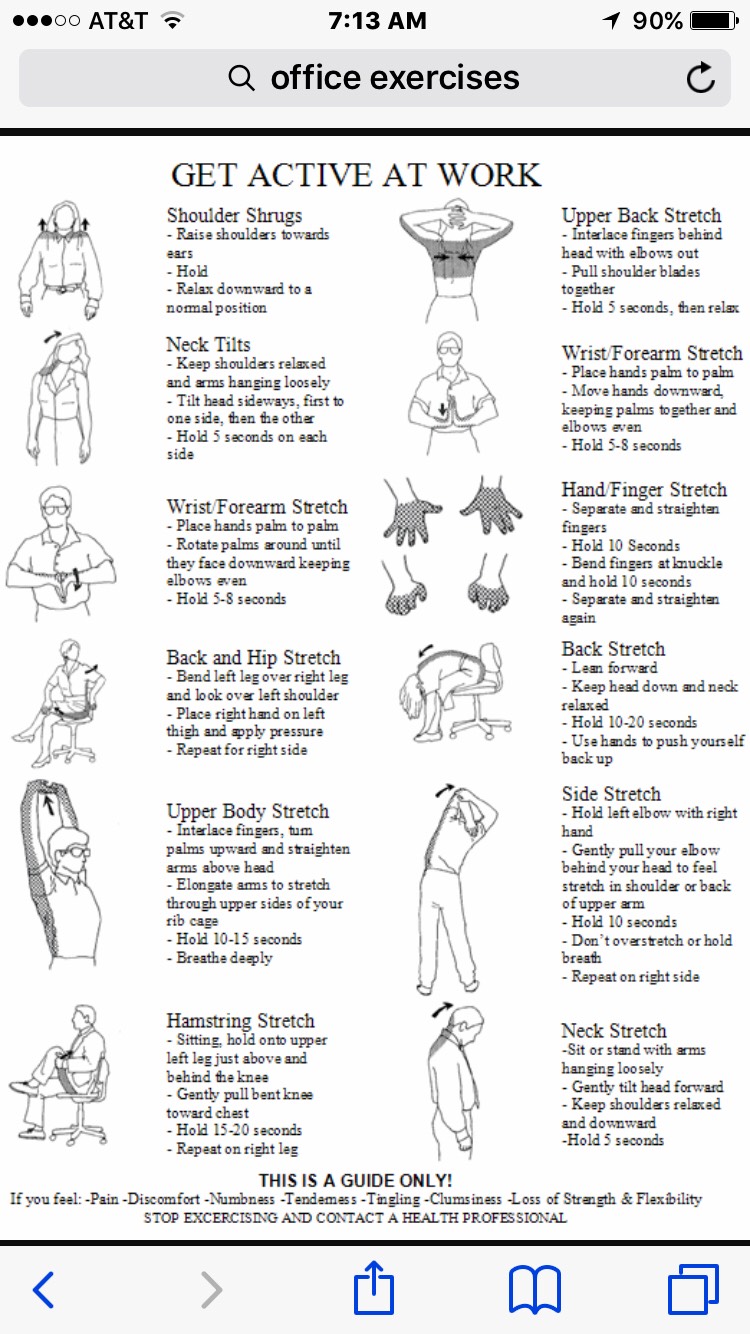
Factors that can influence long-term outcomes include:
- The underlying cause of the pinched nerve
- Age and overall health
- Adherence to treatment plans and lifestyle modifications
- Early intervention and appropriate management
By working closely with your healthcare team and actively participating in your treatment plan, you can optimize your chances of a favorable long-term outcome.
Advances in Cervical Radiculopathy Research and Treatment
The field of spinal health is continuously evolving, with ongoing research and technological advancements aimed at improving diagnosis and treatment of conditions like cervical radiculopathy. What are some of the latest developments in this area?
Diagnostic Innovations
- Advanced imaging techniques for more precise nerve visualization
- Artificial intelligence-assisted image analysis for faster and more accurate diagnoses
- Improved electrodiagnostic testing methods
Treatment Advancements
- Minimally invasive surgical techniques with faster recovery times
- Regenerative medicine approaches, such as stem cell therapy and platelet-rich plasma injections
- Virtual reality-assisted physical therapy programs
- Targeted drug delivery systems for pain management
Future Directions
Researchers continue to explore new avenues for understanding and treating cervical radiculopathy. Some areas of ongoing investigation include:
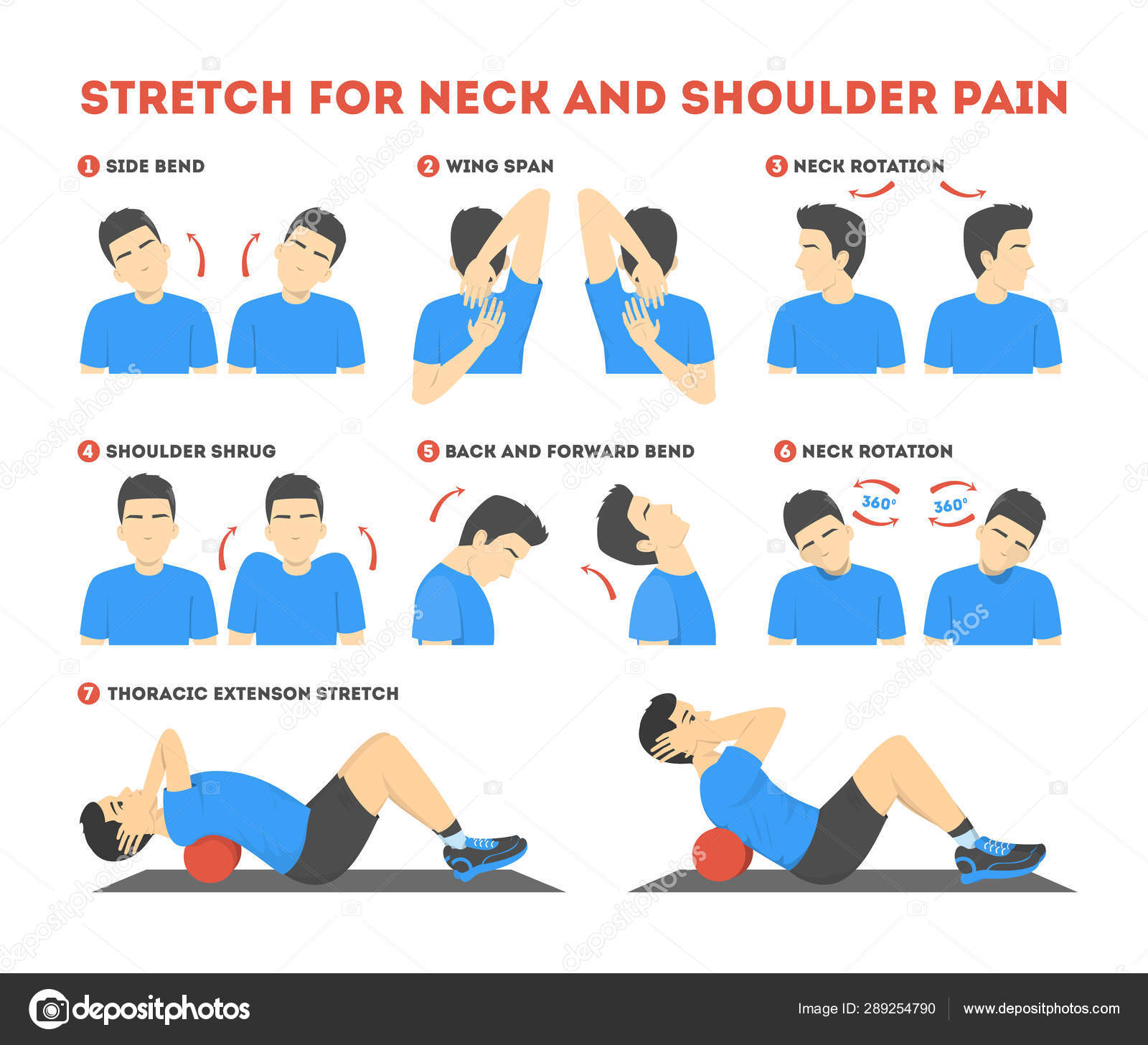
- Genetic factors that may influence susceptibility to pinched nerves
- Novel biomaterials for improved artificial disc replacements
- Neurostimulation techniques for pain modulation
- Personalized treatment approaches based on individual patient characteristics
As research progresses, individuals with cervical radiculopathy can look forward to potentially more effective and tailored treatment options in the future.
Understanding the complexities of cervical radiculopathy, from its causes and symptoms to diagnostic methods and treatment options, empowers individuals to take an active role in their spinal health. By staying informed about the latest developments and working closely with healthcare professionals, those experiencing tingling in the left side of their neck and shoulder can navigate their condition with confidence and optimism.
Four Tests to Determine if You Have a Pinched Nerve in Your Neck
If you have any of the following symptoms, you may be suffering from a pinched nerve:
- Pain in the neck that radiates beyond your elbow or to your fingertips
- Shoulder blade pain
- Hand, arm, or shoulder weakness
- Dull aches, numbness, or tingling
- Pain aggravated by neck movements
If you have any of the aforementioned symptoms, administer this self-movement test to help you determine if a pinched nerve is the cause of your pain:
- Arm tension test:
- First, perform this test on your non-painful arm to determine the natural range of comfortable motion.
- Extend your non-painful arm directly in front of you, keeping your wrist straight and in-line with your arm.
- Turn your wrist outward, so your palm is facing away from your body.
- Extend your arm to the side as far as you can comfortably go. By the end of this movement, your position should look like the image below:
- Try the same movement with your painful arm.
 By the time you extend your wrist, if you begin to feel increased symptoms on the path throughout the arm or in the neck, then stop. You have tested positive for arm tension.
By the time you extend your wrist, if you begin to feel increased symptoms on the path throughout the arm or in the neck, then stop. You have tested positive for arm tension. - If you still do not feel increased symptoms, then continue to extend your arm out to the side.
- If you feel pain, numbness, or tingling in the arm as you extend it, and/or you cannot extend it as far as the non-painful arm, then you have tested positive for arm tension and should continue to the next test.
- If you did not experience symptoms or limited range of motion throughout this test, then stop. It is likely that the source of your pain is not a pinched nerve.
- Neck compression test:
- You should continue to this test if you tested positive for arm tension. Once again, you want to begin on your non-painful side to get a good baseline.
- Tilt your head to the non-painful side (if your left side is your good side, then tilt your head to the left and vice versa).

- Keeping your head titled, rotate your head outwards slightly, as if you were looking over your shoulder
- Hold this position for 30-60 seconds.
- Perform the same movement to the painful side
- If you feel neck pain, pain or tingling that radiates down the arm, or numbness, then you have tested positive.
- Head turn test:
- If you have tested positive for both tests so far, perform this test on your non-painful side first.
- Turn your head to the non-painful side and hold it there for a few seconds. You should have full motion and no pain.
- Turn your head to the painful side and hold it there for a few seconds. If you have limited motion or cannot turn your head as far on this side as you could on your non-painful side, then you have tested positive.
- Relief test:
- For this test, you will want to see if relieving tension on the nerve will reduce your symptoms. You can do this by tilting your head AWAY from the painful side (similar to the compression test).

- Use your non-painful arm to hold it there up to a minute
- Ask yourself if this relieves your symptoms. Do you feel less numbness and tingling in the arm? Or warmth as if your arm is regaining sensation?
- For this test, you will want to see if relieving tension on the nerve will reduce your symptoms. You can do this by tilting your head AWAY from the painful side (similar to the compression test).
If you have tested positive for all four of these exercises, then it’s likely that a pinched nerve may be the source of your pain. If you tested positive, then you may be interested in these home remedies for nerve pain.
*As a reminder, always discuss any questions or concerns with your physician regarding your own health and dietary needs, as the information written should not replace any medical advice.
Cervical Radiculopathy (Pinched Nerve) – OrthoInfo
Cervical radiculopathy, commonly called a “pinched nerve,” occurs when a nerve in the neck is compressed or irritated where it branches away from the spinal cord. This may cause pain that radiates into the shoulder and/or arm, as well as muscle weakness and numbness.
Cervical radiculopathy is often caused by “wear and tear” changes that occur in the spine as we age, such as arthritis. In younger people, it is most often caused by a sudden injury that results in a herniated disk. In some cases, however, there is no traumatic episode associated with the onset of symptoms.
In most cases, cervical radiculopathy responds well to conservative treatment that includes medication and physical therapy.
Your spine is made up of 24 bones, called vertebrae, that are stacked on top of one another. These bones connect to create a canal that protects the spinal cord.
The seven small vertebrae that begin at the base of the skull and form the neck comprise the cervical spine.
Cervical radiculopathy occurs in the cervical spine — the seven small vertebrae that form the neck.
Other parts of your spine include:
Spinal cord and nerves. These “electrical cables” travel through the spinal canal carrying messages between your brain and muscles.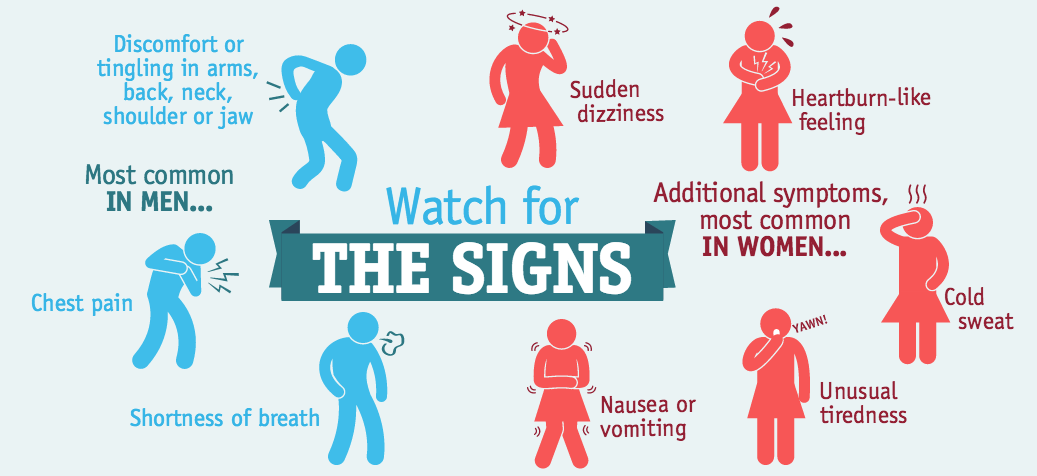 Nerve roots branch out from the spinal cord through openings in the vertebrae (foramen).
Nerve roots branch out from the spinal cord through openings in the vertebrae (foramen).
Intervertebral disks. In between your vertebrae are flexible intervertebral disks. They act as shock absorbers when you walk or run.
Intervertebral disks are flat and round and about a half inch thick. They are made up of two components:
- Annulus fibrosus. This is the tough, flexible outer ring of the disk.
- Nucleus pulposus. This is the soft, jelly-like center of the disk.
A healthy intervertebral disk (cross-section view).
Cervical radiculopathy most often arises from degenerative changes that occur in the spine as we age or from an injury that causes a herniated, or bulging, intervertebral disk.
Degenerative changes. As the disks in the spine age, they lose height and begin to bulge. They also lose water content, begin to dry out, and become stiffer. This problem causes settling, or collapse, of the disk spaces and loss of disk space height.
As the disks lose height, the vertebrae move closer together. The body responds to the collapsed disk by forming more bone—called bone spurs—around the disk to strengthen it. These bone spurs contribute to the stiffening of the spine. They may also narrow the foramen—the small openings on each side of the spinal column where the nerve roots exit—and pinch the nerve root.
(Left) Side view of a healthy cervical vertebra and disk. (Right) A disk that has degenerated and collapsed.
Degenerative changes in the disks are often called arthritis or spondylosis. These changes are normal and they occur in everyone. In fact, nearly half of all people middle-aged and older have worn disks and pinched nerves that do not cause painful symptoms. It is not known why some patients develop symptoms and others do not.
Herniated disk. A disk herniates when its jelly-like center (nucleus) pushes against its outer ring (annulus).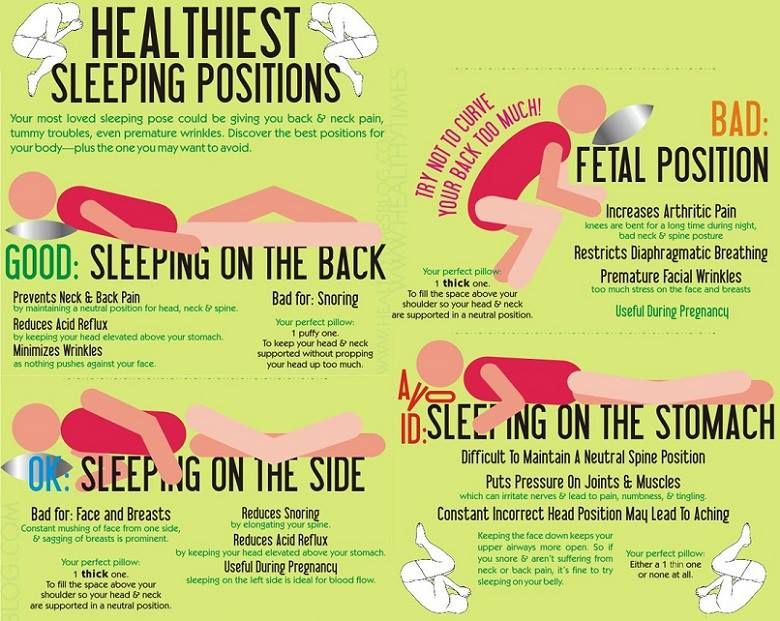 If the disk is very worn or injured, the nucleus may squeeze all the way through. When the herniated disk bulges out toward the spinal canal, it puts pressure on the sensitive nerve root, causing pain and weakness in the area the nerve supplies.
If the disk is very worn or injured, the nucleus may squeeze all the way through. When the herniated disk bulges out toward the spinal canal, it puts pressure on the sensitive nerve root, causing pain and weakness in the area the nerve supplies.
A herniated disk often occurs with lifting, pulling, bending, or twisting movements.
In a herniated disk, the soft, jelly-like center of the disk can push all the way through the outer ring. (Side and cross-section views shown)
In most cases, the pain of cervical radiculopathy starts at the neck and travels down the arm in the area served by the damaged nerve. This pain is usually described as burning or sharp. Certain neck movements—like extending or straining the neck or turning the head—may increase the pain. Other symptoms include:
- Tingling or the feeling of “pins and needles” in the fingers or hand
- Weakness in the muscles of the arm, shoulder, or hand
- Loss of sensation
Some patients report that pain decreases when they place their hands on top of their head.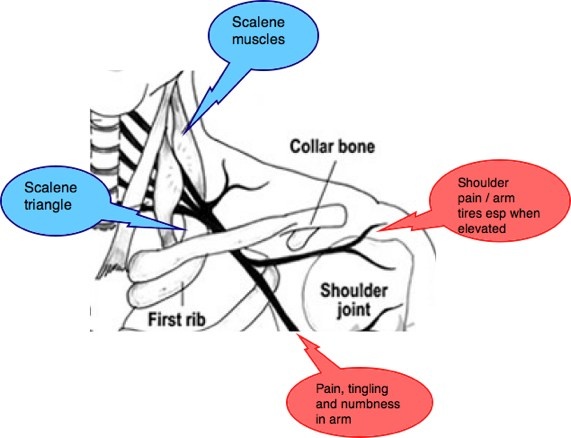 This movement may temporarily relieve pressure on the nerve root.
This movement may temporarily relieve pressure on the nerve root.
Physical Examination
After discussing your medical history and general health, your doctor will ask you about your symptoms. He or she will then examine your neck, shoulder, arms and hands—looking for muscle weakness, loss of sensation, or any change in your reflexes.
Your doctor may also ask you to perform certain neck and arm movements to try to recreate and/or relieve your symptoms.
Tests
X-rays. These provide images of dense structures, such as bone. An x-ray will show the alignment of bones along your neck. It can also reveal whether there is any narrowing of the foramen and damage to the disks.
Computerized tomography (CT) scans. More detailed than a plain x-ray, a CT scan can help your doctor determine whether you have developed bone spurs near the foramen in your cervical spine.
Magnetic resonance imaging (MRI) scans. These studies create better images of the body’s soft tissues. An MRI of the neck can show if your nerve compression is caused by damage to soft tissues—such as a bulging or herniated disk. It can also help your doctor determine whether there is any damage to your spinal cord or nerve roots.
These studies create better images of the body’s soft tissues. An MRI of the neck can show if your nerve compression is caused by damage to soft tissues—such as a bulging or herniated disk. It can also help your doctor determine whether there is any damage to your spinal cord or nerve roots.
Electromyography (EMG). Electromyography measures the electrical impulses of the muscles at rest and during contractions. Nerve conduction studies are often done along with EMG to determine if a nerve is functioning normally. Together, these tests can help your doctor determine whether your symptoms are caused by pressure on spinal nerve roots and nerve damage or by another condition that causes damage to nerves, such as diabetes.
This MRI image shows bulging disks pressing on the spinal cord (red arrows).
Reproduced from Boyce R, Wang J: Evaluation of Neck pain, radiculopathy and myelopathy: imaging, conservative treatment, and surgical indications.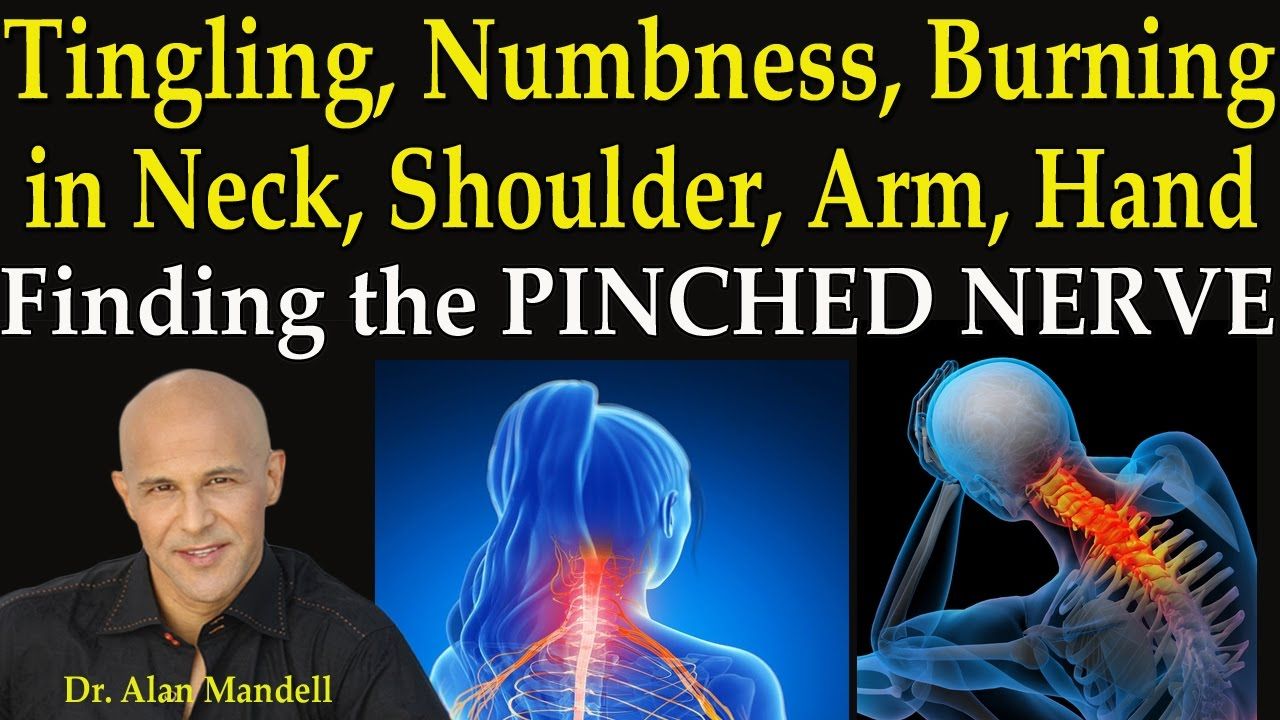 Instructional Course Lectures 52. Rosemont, IL, American Academy of Orthopaedic Surgeons, 2003, pp 489-495.
Instructional Course Lectures 52. Rosemont, IL, American Academy of Orthopaedic Surgeons, 2003, pp 489-495.
It is important to note that the majority of patients with cervical radiculopathy get better over time and do not need treatment. For some patients, the pain goes away relatively quickly—in days or weeks. For others, it may take longer.
It is also common for cervical radiculopathy that has improved to return at some point in the future. Even when this occurs, it usually gets better without any specific treatment.
In some cases, cervical radiculopathy does not improve, however. These patients require evaluation and treatment.
Nonsurgical Treatment
Initial treatment for cervical radiculopathy is nonsurgical. Nonsurgical treatment options include:
Soft cervical collar. This is a padded ring that wraps around the neck and is held in place with Velcro. Your doctor may advise you to wear a soft cervical collar to allow the muscles in your neck to rest and to limit neck motion.:max_bytes(150000):strip_icc()/pinched-nerve-headache-treatment-1719581-5c04ae4146e0fb0001cc1846-63608779dc594598ae4331423b0d2aed.png) This can help decrease the pinching of the nerve roots that accompany movement of the neck. A soft collar should only be worn for a short period of time since long-term wear may decrease the strength of the muscles in your neck.
This can help decrease the pinching of the nerve roots that accompany movement of the neck. A soft collar should only be worn for a short period of time since long-term wear may decrease the strength of the muscles in your neck.
Physical therapy. Specific exercises can help relieve pain, strengthen neck muscles, and improve range of motion. In some cases, traction can be used to gently stretch the joints and muscles of the neck.
Medications. In some cases, medications can help improve your symptoms.
- Nonsteroidal anti-inflammatory drugs (NSAIDs). NSAIDs, including aspirin, ibuprofen, and naproxen, may provide relief if your pain is caused by nerve irritation or inflammation.
- Oral corticosteroids. A short course of oral corticosteroids may help relieve pain by reducing swelling and inflammation around the nerve.
Steroid injection. In this procedure, steroids are injected near the affected nerve to reduce local inflammation. The injection may be placed between the laminae (epidural injection), in the foramen (selective nerve injection), or into the facet joint. Although steroid injections do not relieve the pressure on the nerve caused by a narrow foramen or by a bulging or herniated disk, they may lessen the swelling and relieve the pain long enough to allow the nerve to recover.
The injection may be placed between the laminae (epidural injection), in the foramen (selective nerve injection), or into the facet joint. Although steroid injections do not relieve the pressure on the nerve caused by a narrow foramen or by a bulging or herniated disk, they may lessen the swelling and relieve the pain long enough to allow the nerve to recover.
Illustration shows a cervical steroid injection.
Narcotics. These medications are reserved for patients with severe pain that is not relieved by other options. Narcotics are usually prescribed for a limited time only.
Surgical Treatment
If, after a period of time, nonsurgical treatment does not relieve your symptoms, your doctor may recommend surgery. There are several surgical procedures to treat cervical radiculopathy. The procedure your doctor recommends will depend on many factors, including what symptoms you are experiencing and the location of the involved nerve root.
Learn more about surgery for radiculopathy: Cervical Radiculopathy: Surgical Treatment Options
To Top
Pain in the neck on the left side
Why it hurts only on the left side
The causes of pain in the neck on the left side usually coincide with those that cause this part of the body to hurt in other places. Simply, for example, in case of protrusion or herniation of the intervertebral disc, only the left roots of the spinal nerves are clamped, while the right ones are free and continue to function.
Simply, for example, in case of protrusion or herniation of the intervertebral disc, only the left roots of the spinal nerves are clamped, while the right ones are free and continue to function.
There are other nerves, which, when inflamed, give one-sided painful sensations in the cervical region. This, for example, the brachial plexus or the occipital nerves.
Another cause of one-sided pain is trauma: not necessarily a bruise, it can be a sudden movement or a jerk in transport. Clamped (tense, not stretched) after a long time in the wrong position, the muscle is enough to cause a sharp pain in the neck on the left.
Tumors of the spine rarely give unilateral pain, but this situation cannot be ruled out. Including therefore the doctor necessarily prescribes an examination of the patient.
How disturbing
Neck pain has a number of symptoms that make it possible to suspect a specific disease. Sometimes, based on the patient’s complaints and examination alone, the doctor can establish a diagnosis and prescribe treatment. This is done in order to alleviate the condition of the person, he will still have to undergo examinations to confirm or clarify the opinion of the doctor. For example,
This is done in order to alleviate the condition of the person, he will still have to undergo examinations to confirm or clarify the opinion of the doctor. For example,
- pulling pain in the neck on the left most likely indicates osteochondrosis or other problems associated with the spine;
- if the neck hurts on the left side, in this place the fingers find a ball, pressing on which is painful, probably the lymph node has become inflamed, it is impossible to heat, a therapist is needed;
- when a muscle on the neck on the left or behind hurts, and it even feels like a microtrauma, this should go away on its own in 2-3 days;
- if pain from the neck radiates to other parts of the body – arm, shoulder, shoulder blade –
- when the neck hurts on the left and the head on the left, most likely, a neurologist is needed: unilateral pain in the head is a likely sign of migraine, and sometimes it spreads to the neck;
- if the pain from the neck clearly radiates to the head on the left, this is also a neurologist, this is how occipital nerve neuritis manifests itself;
- when the neck and shoulder hurt at the same time, while turning the head to the left makes the pain difficult, this is similar to the symptoms of plexitis, in which the pain is always one-sided, but there is no point in treating the neck in this case, the cause of the disease is in the brachial plexus;
- when it bothers you from the front below, close to the jugular cavity, you need to get to the therapist as soon as possible, this may indicate problems with the thyroid gland;
- if the neck and ear hurt at the same time on one side, it is most likely otitis, a doctor is needed in the near future, in extreme cases, the on-duty therapist will do.

A bit about non-obvious reasons. Pain with cholecystitis can be given to the neck, and an attack of angina pectoris can also occur. Sometimes these sensations appear after a stroke. There are other diseases in which pain that has arisen far from the disturbing part of the body leads to a symptom that is easily confused with osteochondrosis. Therefore, it is better to visit a doctor, otherwise there is a risk of missing a severe or even life-threatening disease.
We are looking for the cause
When the neck hurts on the left side, diagnosis is usually not difficult. The main thing that the doctor needs to find out is whether there is an intervertebral hernia. For this, an x-ray of the cervical spine is prescribed in two projections. If you need to clarify the diagnosis, the next step will be magnetic resonance imaging of the affected area. All types of diseases associated with the spine and adjacent soft tissues will help to identify these two studies.
Diagnosis of diseases not directly related to the neck, other parts of the spine and adjacent nerve plexuses is the task of doctors in whose competence the organs and systems that have come under suspicion as a source of pain. Since the causes in this case may be different, diagnostic methods are used that are not similar to each other, so it makes no sense to describe them.
How to get rid of pain
If pain in the neck on the left occurs due to diseases of the spine or muscles, the treatment will be the same as for similar problems in other areas of the back: anti-inflammatory tablets and ointments, physiotherapy, massage, then in some cases physiotherapy exercises .
What should I do if my neck hurts on the left side, and the visit to the doctor is only tomorrow morning? You can use anti-inflammatory gels or ointments. Means with diclofenac in the composition will not harm if the skin over the sore spot is not damaged. Warming ointments can be used for pain due to physical exertion, or vice versa, an uncomfortable static posture, but it is absolutely impossible if there is a possibility of injury.
If pain in the neck is not associated with the spine, or is caused, for example, by a tumor, abscess, inflammation of the nerve plexus, such treatment will not help, you need to look for and eliminate the cause. But guessing in this case is useless: medical assistance is needed.
New furniture as a remedy for pain
If you often have pain on the left side, pay attention to the furniture, bedding and the location of the air conditioner. You may have to sit with your head tilted to the left or right too often. In this case, you need to rearrange the furniture to suit your needs, and if we are talking about an office, try at least turning the chair and monitor around so that the posture becomes less tense. An uncomfortable pillow may interfere, it should be replaced with an orthopedic one. And, finally, if a jet of air conditioning hits exactly in the neck, this is a good reason to adjust the device so that it blows over your head.
Before the mass introduction of air conditioning in the automotive industry, recurrent acute pain in the neck on the left bothered drivers who left a narrow gap between the side window and the door. Such ventilation led to inflammation of the muscles. Passengers had the same problem, but on the right. To prevent such pain, you need to turn on the air conditioner, open the window wide or open it from the side where the passenger is not sitting next to the door.
Such ventilation led to inflammation of the muscles. Passengers had the same problem, but on the right. To prevent such pain, you need to turn on the air conditioner, open the window wide or open it from the side where the passenger is not sitting next to the door.
The rest of the prevention measures for neck pain are the same as for other spinal diseases: maintaining correct posture, an ergonomic workplace, and regular gymnastics.
When doing gymnastics, it is necessary to avoid sudden movements of the neck, all exercises in this area are performed smoothly, without jerks. This is especially true of the warm-up stage: the better it is done, the less likely it is to be injured. A good instructor will recommend at the end of an intensive session to do a hitch – a set of exercises that prepares the body for the transition to a state of rest.
Healthy Spine Clinics “Zdravvuy!” certified doctors with many years of experience work. Among them are doctors and candidates of medical sciences, professors and doctors of the highest qualification category, teachers of the Department of Osteopathy and Manual Therapy of the Federal State Autonomous Educational Institution of Higher Education “Peoples’ Friendship University of Russia”. All of them have extensive experience of inpatient work in the leading medical and preventive institutions of the city of Moscow and form the strongest team of experts in the field of diagnosis and treatment of diseases of the musculoskeletal system.
All of them have extensive experience of inpatient work in the leading medical and preventive institutions of the city of Moscow and form the strongest team of experts in the field of diagnosis and treatment of diseases of the musculoskeletal system.
Comprehensive treatment in the clinics of the network is carried out by doctors in such specialized areas as traumatology and orthopedics, manual therapy and osteopathy, neurology and therapy, physiotherapy and reflexology, as well as specialists in other medical professions in demand among the population (cardiology, surgery, nutrition). Unique methods and innovative equipment in Zdravstvuy! clinics allow you to quickly and accurately make the correct diagnosis, and most importantly, competently prescribe the necessary course of effective therapy.
Why does the neck hurt: causes and treatment. Relieve neck pain.
Why does the neck hurt and how does the pain affect the quality of life?
Neck pain is one of the most common health complaints. There are several reasons, but they are all related to the condition of the spine. Often, pain occurs due to spasms in the muscles of the neck, which are the result of compression of the nerve roots in the cervical spine. As a rule, pain in the neck and pinched nerves are caused by osteochondrosis or osteoarthrosis of the cervical vertebrae, or by intervertebral hernias.
There are several reasons, but they are all related to the condition of the spine. Often, pain occurs due to spasms in the muscles of the neck, which are the result of compression of the nerve roots in the cervical spine. As a rule, pain in the neck and pinched nerves are caused by osteochondrosis or osteoarthrosis of the cervical vertebrae, or by intervertebral hernias.
Persistent neck pain: common causes
- Osteochondrosis of the cervical spine can cause sharp pain in the neck or pain that radiates to the arm. Sometimes such pain is associated with tumors in the spine, so if it does not go away for a long time, you should consult a doctor. Often, discomfort in the neck occurs after physical exertion, hypothermia in a draft, or a long stay in an uncomfortable position (for example, while sleeping or talking on the phone, pressed shoulder to ear). As a rule, such pain in the neck subsides within a few days.
- With osteochondrosis of the cervical spine, pain in the neck may be accompanied by dizziness.
 If this symptom occurs, it is necessary to consult a doctor and make sure that the problem is related to the condition of the spine.
If this symptom occurs, it is necessary to consult a doctor and make sure that the problem is related to the condition of the spine. - Localization of pain in the shoulder may indicate the presence of a hernia in the cervical spine. Hernias lead to compression or infringement of the nerve roots, causing pain to spread to the shoulder or arm. The process may be accompanied by a headache. Compression of the nerve provokes muscle spasm, because of this, blood circulation is disturbed at the site of the lesion and there are constant pains in the neck. All this slows down recovery. Therefore, for pain in the neck, especially associated with infringement of the nerve roots, massages of spasmodic areas are recommended. Due to a herniated disc in the cervical spine, sensitivity in the hand may decrease, and muscle strength may decrease.
Pain from exertion and diseases
Pain in the neck due to muscle tension is typical for those who have static loads, for example, when sitting at a computer or sewing machine.
Systemic diseases causing neck pain – rheumatoid arthritis, polymyalgia rheumatica, ankylosing spondylitis, as well as tumors and infectious diseases.
Since pulling pains in the neck can be a symptom of the presence of a tumor, some infectious and autoimmune diseases, it is necessary to consult a doctor if the pain does not go away for several weeks or intensifies.
Neck pain due to muscle tension is typical for those who have static loads, for example, when sitting at a computer or sewing machine.
Systemic diseases causing neck pain – rheumatoid arthritis, polymyalgia rheumatica, ankylosing spondylitis, as well as tumors and infectious diseases.
Since pulling pains in the neck can be a symptom of the presence of a tumor, some infectious and autoimmune diseases, it is necessary to consult a doctor if the pain does not go away for several weeks or intensifies.
How to treat neck pain?
Treatment for neck pain consists of physiotherapy, medications to reduce pain, as well as the right mental attitude and stress management.

 By the time you extend your wrist, if you begin to feel increased symptoms on the path throughout the arm or in the neck, then stop. You have tested positive for arm tension.
By the time you extend your wrist, if you begin to feel increased symptoms on the path throughout the arm or in the neck, then stop. You have tested positive for arm tension.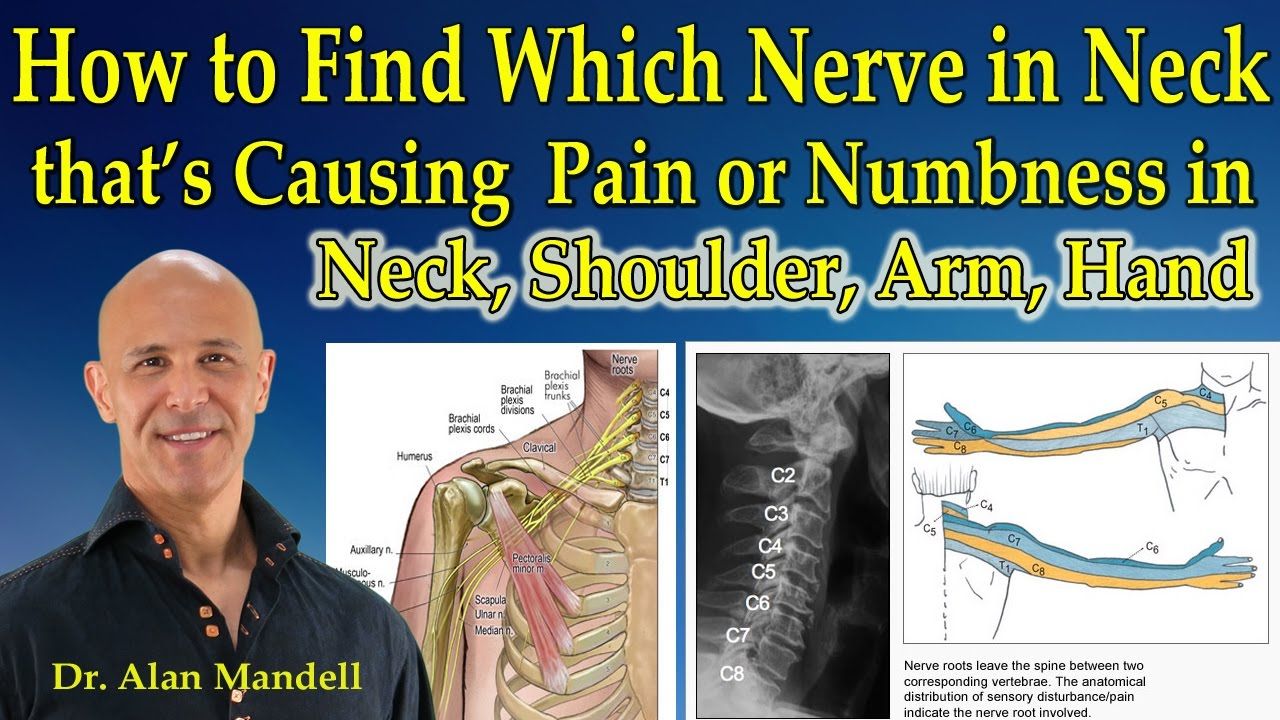


 If this symptom occurs, it is necessary to consult a doctor and make sure that the problem is related to the condition of the spine.
If this symptom occurs, it is necessary to consult a doctor and make sure that the problem is related to the condition of the spine.